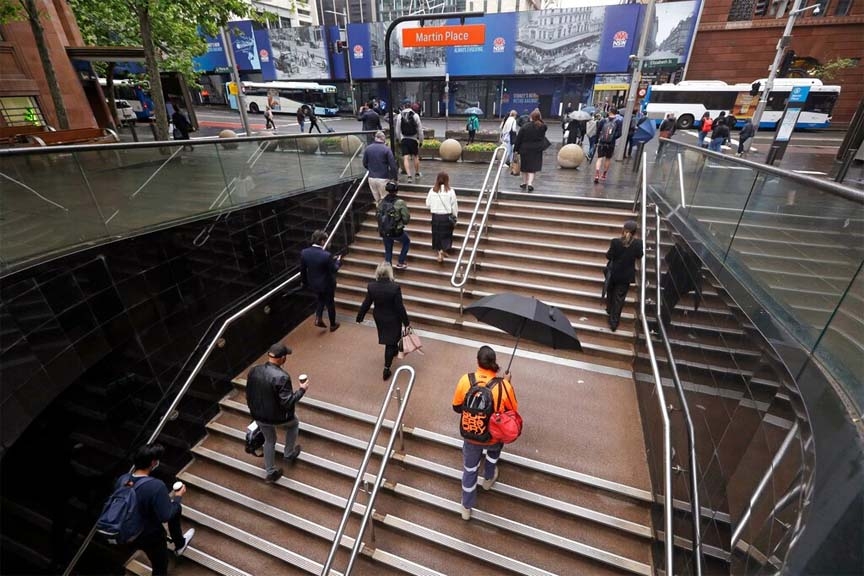
AFP, SYDNEY :
Elated Sydneysiders defied grey skies and drizzle to celebrate the end of almost four months of lockdown on Monday, hoping to put behind them a period of “blood, sweat and no beers” in Australia’s largest city.
Sydney’s more than five million residents have been subjected to a 106-day lockdown, designed to limit the march of the highly transmissible Delta variant.
With new infections now falling—New South Wales state recorded 496 cases on Monday—and more than 70 percent of over-16s double vaccinated, the city is dusting off the cobwebs.
Cafes and restaurants threw open their doors to anyone who could prove they were vaccinated, including 35-year-old Peter Morgan, who was among those relishing in newly regained freedoms.
“Even though it’s like freezing outside it’s so good,” he said. “It’s just these little things which offset a lot of the stresses of like being locked down.”
“The first thing I’m going to do is see my parents. Actually no, not see my parents. I’m going to go to Lakemba to get a Lebanese mixed plate and then go see my parents,” he said.
Across the city shaggy haired customers lined up outside hairdressers to get eyebrow-raising home cuts and dye jobs repaired.
“I couldn’t wait to be in here to get the hair done,” said Brett Toelle, a salon customer in Surry Hills, whose last trim was 15 weeks ago. “That’s the longest time I’ve ever been without a haircut.”
For many, the end of lockdown was a chance to get into the shops.
At midnight, hundreds of people poured into a discount Kmart store in the western Sydney suburb of Mount Druitt, with social media images showing long queues forming inside.
For others, it was a chance to put their business back on track.
“It’s a great vibe this morning,” said Hannah Simmons, owner of Gordon’s Cafe in the beachside suburb of Clovelly whose business survived the lockdown by offering takeaway.
“The outside seating will be a little bit dreary but that’s OK. We are really excited to be back there and open. That’s great.”
Since June, shops, schools, salons and offices have been closed for non-essential workers and there have been unprecedented restrictions on personal freedom.
There were bans on everything from travelling more than five kilometres (three miles) from home, visiting family, playing squash, browsing in supermarkets to attending funerals.
“Very few countries have taken as stringent or extreme an approach to managing Covid as Australia,” Tim Soutphommasane, an academic and former Australian race discrimination commissioner, told AFP.
For most of the pandemic, Australia successfully suppressed infections through border closures, lockdowns and aggressive testing and tracing.
But the Delta variant put paid to any dream of “Covid-zero”, at least in the largest cities of Melbourne and Sydney which are now pivoting to “living with Covid”.
“It’s a big day for our state,” said New South Wales’ recently appointed conservative premier Dominic Perrottet.
After “100 days of blood, sweat and no beers,” he said, “you’ve earned it.”
Prime Minister Scott Morrison hailed the day as one to celebrate things once taken for granted: “Being with family and friends, getting a haircut, grabbing a meal together, going to the pub and having a beer with your mates.”
There will still be limits on mass gatherings and international borders and schools will not fully reopen for a few weeks yet.
But otherwise daily life is beginning to look more like normal, with crowds again gathering at bus stops and the hum of traffic growing a little louder.
Despite the celebratory mood, there are lingering concerns that reopening will bring a surge in infections.
The Australian Medical Association pilloried Perrottet when he appeared to shift the focus away from health and onto the economic recovery.
“The AMA supports gradual opening up of the economy and the loosening of restrictions, but it is critical to observe the impact of each step on transmission and case numbers,” the doctors’ body said.
“Otherwise New South Wales may still see hospitals become completely overwhelmed despite high vaccination rates.”

